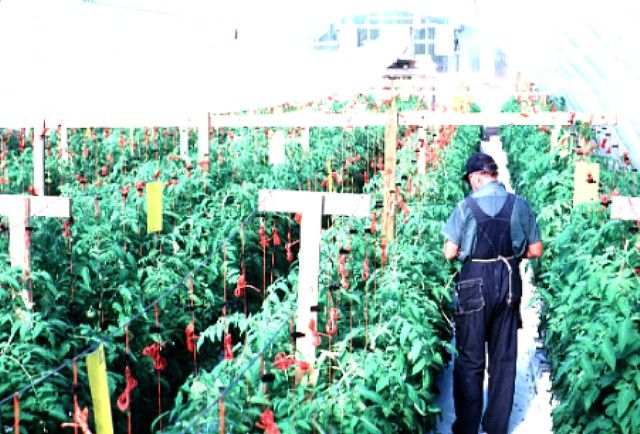Crop Production—Florida Greenhouse Vegetable Production Handbook, Vol 1
The prospective greenhouse grower must have in mind the crop to be produced and the marketing strategy for that crop. This section presents some of the major considerations regarding crop production.
Presently, there appears to be a good market for greenhouse tomatoes and a fair, but more volatile market for cucumbers, herbs, peppers, and lettuce. Cultivars of these greenhouse crops differ greatly from the cultivars of the crops grown outdoors.
Greenhouse tomato plants are generally larger than their field-grown counterparts. Greenhouse tomatoes are indeterminate which means that they grow and produce fruits continually. Therefore, the greenhouse tomato plant may reach 20 or more feet in length, requiring trellising. Fruit must be picked frequently (as much as every second day) to maintain the desired state of maturity and quality. Greenhouse tomatoes must be pruned and tied regularly to maintain quality and production. Flowers must be vibrated at least three days a week to ensure adequate pollination for fruit development. Most tomatoes are harvested as single fruits, but recently cluster tomatoes, where the entire cluster of fruits is harvested at once with fruits attached to stems, have become popular.
Cucumbers produced in the greenhouse are of the "European" type, a long, slender, seedless, mild, thinskinned fruit. More recently, short-fruited beit-alpha cucumbers, popular in the Middle East, are becoming popular here. In general, cucumbers are slightly more difficult to grow than tomatoes because of the lack of disease resistance and the paucity of pest control chemicals. Greenhouse cucumbers are trellised and pruned and, like tomatoes, the vines achieve great lengths in a mature crop. Unlike tomatoes, greenhouse cucumbers require no pollination. This is because these types of cucumbers are parthenocarpic, producing fruit without pollination. In fact, the greenhouse cucumber grower will need to ensure that bees carrying cucumber pollen from a field cucumber crop do not enter the greenhouse. Otherwise the greenhouse cucumbers will develop seeds and will be unmarketable. Greenhouse "European" cucumbers require shrink-wrapping of each fruit in order to market them. Therefore, greenhouse cucumber growers will need to purchase or have access to a shrink-wrap machine. Beit-alpha types do not require shrink-wrapping.
Peppers and lettuce grown in the greenhouse also are different from field peppers and lettuce. These two crops require more exacting environmental conditions for optimum growth and quality than do tomatoes and cucumbers. High temperatures (above 85 °F) can reduce fruit set of pepper and can lead to bitter tasting lettuce. Greenhouse herbs and speciality lettuces have increased in Florida in recent years. These crops are difficult to produce in Florida greenhouses. In addition, there is a negligible number of chemical pest control products labeled for greenhouse peppers, lettuce, or herbs.
Seeds and transplants for greenhouse vegetables are expensive (¼ oz of tomato seed for one typical house might cost $60–$80). These vegetables are usually started from seed in small blocks of rockwool or similar inert substances. Transplants then are placed in the greenhouse to be grown to maturity. High quality transplants are critical to the success of greenhouse vegetable crops. It is strongly advised that growers produce their own transplants to avoid pests or pathogen contamination during transplant production or transport.
Various production systems can be used in the greenhouse to grow the crop. These systems include nutrient film technique (NFT) and various versions of traditional NFT, perlite, rockwool, peat and bark mixes, lay-flat bags, upright bags, trough culture, pot culture, and ground culture. Most studies that have attempted to compare several of these systems have found that there are very few differences as far as productivity when each system is managed properly. The choice of production system depends largely on grower's preference and on marketing constraints since some markets may demand true NFT and not soil-produced vegetables.
Each cultural system has its own set of requirements for management and successful crops are routinely possible with any system as long as production details are understood. For example, NFT requires precise management of fertilizer and irrigation programs. NFT system components are reusable, therefore the system components are relatively inexpensive when amortized over many crops. A major disadvantage of NFT is that it is a recirculating system. The fertilizer solution circulates from the plants to the reservoir in a closed-system fashion. If a disease causing pathogen is introduced into the system, it can easily infect all of the plants in the house. Therefore frequent flushes and extreme vigilance are required to help provide sanitation in the NFT system.
Perlite and rockwool systems also rely on precise water and fertilizer management but are not closed systems. Plants are grown in individually wrapped slabs of rockwool or bags/pots of perlite and receive the water and fertilizer from a microsystem. Excess water and fertilizer solution leaches from the media and is removed from the greenhouse. The rockwool or perlite, however, must be replaced every season or two. The media expense for one 4000 sq. ft. house may run from $500 to $1000. This would be less costly on a per year basis if several succesive crops are grown in the same media.
Any production system requires diligent sanitation between crops. This involves removing old plants, and bleaching, fumigating, or steaming production system components and growing surfaces.
Crop production and maintenance requires several man-hours per greenhouse every day. A grower must be able to balance the demands of the greenhouse work load with demands from other occupations and with demands and needs of the family. Vacation days are hard to find for the greenhouse vegetable operator. Management operations include formulating fertilizer solutions, monitoring irrigation systems, checking greenhouse operations such as heating and cooling, pruning and tying the crop, pollinating tomatoes, spraying for pest control, cluster pruning tomatoes, harvesting, grading, packing, transporting, and accounting book work, among others. All of these operations must be done precisely on time. Therefore, the grower must be committed to doing a good job of management or must have competent labor. Attention to detail will separate the good growers from the poor ones (Fig. 1). Don't underestimate the amount of time required to properly manage one greenhouse full of vegetable plants.

Finally, be sure of the sources of technical support upon which you will rely. Many specialized agricultural enterprises find it difficult to locate assistance when needed. Determine and identify sources of help including UF/IFAS Extension agents, local industry and supply representatives, and other established growers. Obtain as many useful publications as possible and regularly attend University-sponsored education programs and workshops.
More Information
For more information on greenhouse crop production, please visit our website at http://smallfarms.ifas.ufl.edu.
For the other chapters in the Greenhouse Vegetable Production Handbook, see the documents listed below:
Volume 1: Introduction • Financial Considerations • Pre-Construction Considerations • Crop Production • Considerations for Managing Greenhouse Pests • Summary
Volume 2: Physical Greenhouse Design Considerations • Production Systems • Other Design Information Resources
Volume 3: Preface • General Aspects of Plant Growth • Production Systems • Irrigation of Greenhouse Vegetables • Fertilizer Management for Greenhouse Vegetables • Production of Greenhouse Tomatoes • Greenhouse Cucumber Production • Greenhouse Nematode Management • Alternative Greenhouse Crops • Vegetable Insect Identification and Management



